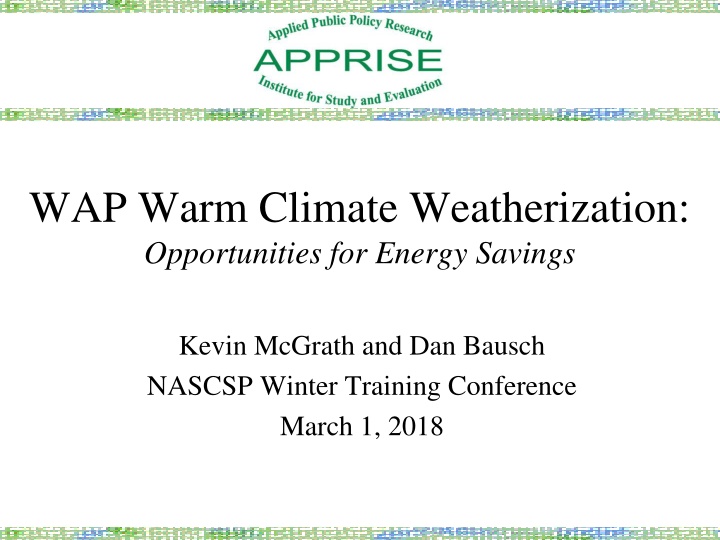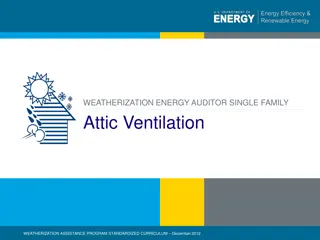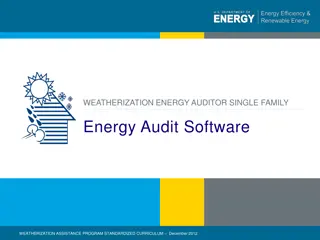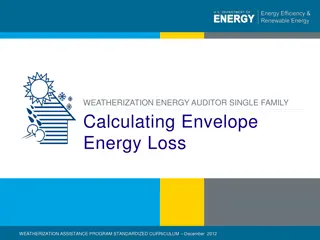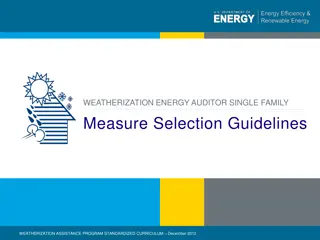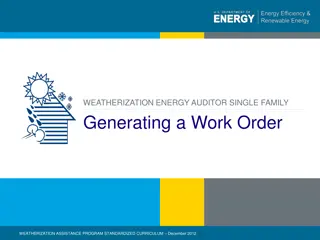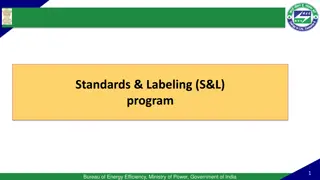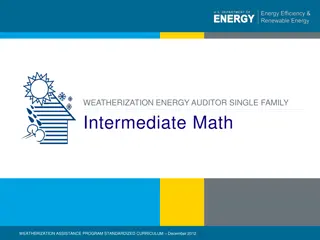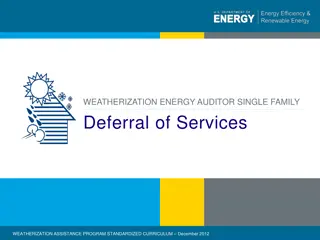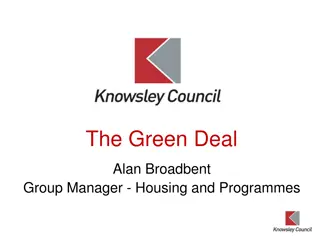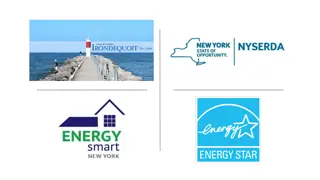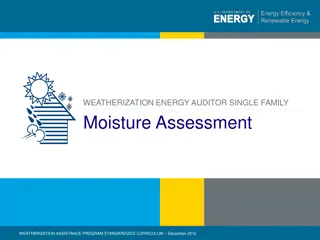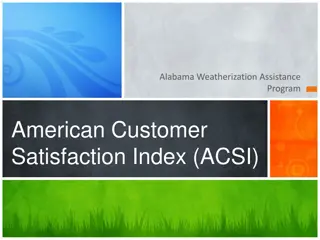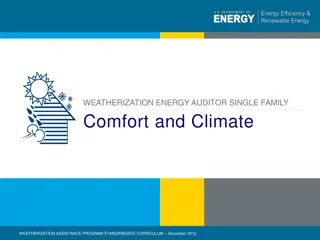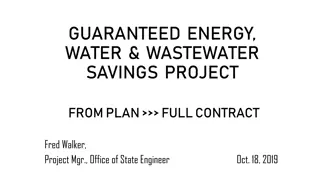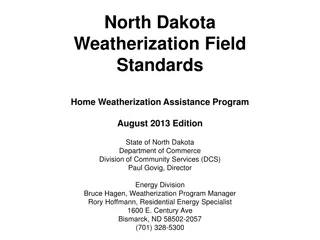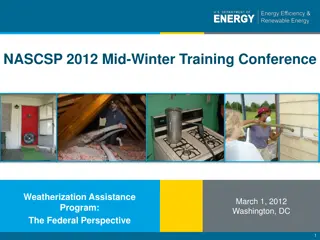WAP Warm Climate Weatherization Opportunities for Energy Savings
The presentation discusses the opportunities for energy savings through weatherization in warm climates, focusing on needs assessment, WAP performance, and new LIHEAP measures. Data on eligible populations, population served, climate zones, and average annual energy consumption in low-income households are also presented. Recommendations for using source energy for equitable comparisons are highlighted.
Download Presentation

Please find below an Image/Link to download the presentation.
The content on the website is provided AS IS for your information and personal use only. It may not be sold, licensed, or shared on other websites without obtaining consent from the author.If you encounter any issues during the download, it is possible that the publisher has removed the file from their server.
You are allowed to download the files provided on this website for personal or commercial use, subject to the condition that they are used lawfully. All files are the property of their respective owners.
The content on the website is provided AS IS for your information and personal use only. It may not be sold, licensed, or shared on other websites without obtaining consent from the author.
E N D
Presentation Transcript
WAP Warm Climate Weatherization: Opportunities for Energy Savings Kevin McGrath and Dan Bausch NASCSP Winter Training Conference March 1, 2018
Outline I. Needs Assessment What is the level of need for low- income weatherization in warm climates? II. WAP Performance in Warm Climates What can results from the National ARRA-period Evaluation tell us about WAP success in warm climates? III. New LIHEAP Performance Measures What can the new data that states are collecting for LIHEAP reporting tell us about opportunities in warm states? 2
Needs Assessment for Low-Income Weatherization in Warm Climates 3
WAP Eligible Population Total WAP Eligible Households % Eligible for WAP Zone Households Very Cold 11,815,195 3,496,585 29.6% Cold 37,436,040 11,089,262 29.6% Moderate 25,296,900 8,068,110 31.9% Hot-Humid 27,793,529 9,753,464 35.1% Hot-Dry 16,518,389 5,224,098 31.6% United States 118,860,053 37,631,519 31.7% Source: 2016 American Community Survey (ACS) 5
WAP Population Served Total Funding Last 10 Years (Billions) Total Units Served Last 10 Years WAP Eligible Households % Served Last 10 Years Zone Very Cold 3,496,585 $2.420 261,995 7.5% Cold 11,089,262 $3.898 732,939 6.6% Moderate 8,068,110 $1.587 256,488 3.2% Hot-Humid 9,753,464 $0.787 102,019 1.0% Hot-Dry 5,224,098 $1.026 197,038 3.8% United States 37,631,519 $9.719 1,550,479 4.1% Source: 2016 ACS, WAPTAC Funding Survey (PY2006-PY2015) 6
Average Annual Consumption (MMBtus) Low-Income Households Total Census Region Residential Energy Home Heating Home Cooling Northeast 99.0 58.3 1.7 Midwest 107.7 59.3 2.3 South 66.0 19.7 7.3 West 60.3 18.7 3.3 United States 80.7 35.9 4.4 Source: FY 2014 LIHEAP Home Energy Notebook Estimates Low-income = households income-eligible for LIHEAP under federal guidelines 8
Source Energy EPA recommends using source energy when comparing across different fuel mixes. EPA has determined that source energy is the most equitable unit of evaluation. Source energy represents the total amount of raw fuel that is required to operate the building. It incorporates all transmission, delivery, and production losses. By taking all energy use into account, the score provides a complete assessment of energy efficiency in a building. Source: https://portfoliomanager.energystar.gov/pdf/reference/Source%20Energy.pdf 9
Average Annual Consumption (MMBtus) Low-Income Households Source Energy Total Census Region Residential Energy Home Heating Home Cooling Northeast 150.2 64.4 5.2 Midwest 180.8 69.9 7.1 South 160.3 32.9 23.0 West 121.9 26.7 10.4 United States 155.2 46.1 13.9 Source: FY 2014 LIHEAP Home Energy Notebook Estimates Converted to Source Energy Low-income = households income-eligible for LIHEAP under federal guidelines 10
Average Annual Expenditures Low-Income Households Total Census Region Home Heating Home Cooling Residential Energy Northeast $1,130 $85 $2,520 Midwest $759 $75 $1,935 South $415 $266 $1,859 West $279 $128 $1,342 United States $601 $164 $1,894 Source: FY 2014 LIHEAP Home Energy Notebook Low-income = households income-eligible for LIHEAP under federal guidelines 11
Average Annual Energy Burden Low-Income Households Total Residential Energy Home Heating Home Cooling Census Region Mean Median Mean Median Mean Median Northeast 11.6% 4.6% 0.9% 0.3% 20.8% 11.1% Midwest 9.6% 3.4% 0.9% 0.3% 18.9% 9.2% South 5.9% 2.1% 3.7% 1.2% 20.5% 9.9% West 3.3% 0.9% 1.2% 0.3% 11.8% 5.5% United States 7.3% 2.4% 1.3% 0.5% 18.4% 9.5% Source: FY 2014 LIHEAP Home Energy Notebook Low-income = households income-eligible for LIHEAP under federal guidelines 12
WAP Eligible Population: Main Heating Fuel Zone EL NG FO/KER LPG Other Very Cold 22% 56% 7% 9% 6% Cold 24% 59% 9% 4% 4% Moderate 56% 31% 3% 5% 5% Hot-Humid 73% 21% 0% 3% 3% Hot-Dry 38% 52% 0% 3% 7% United States 45% 42% 4% 4% 4% Source: 2016 ACS 13
WAP Eligible Population: Owner/Renter Status Zone Own Rent Other Very Cold 49% 48% 3% Cold 42% 56% 3% Moderate 46% 50% 4% Hot-Humid 48% 48% 4% Hot-Dry 37% 60% 3% United States 44% 52% 3% Source: 2016 ACS 14
WAP Eligible Population: Housing Unit Type Small Multifamily (2-4 units) Large Multifamily (5+ units) Single Family Mobile Homes Zone Very Cold 58% 11% 24% 8% Cold 50% 16% 29% 5% Moderate 57% 9% 21% 13% Hot-Humid 56% 9% 22% 13% Hot-Dry 52% 10% 30% 7% United States 54% 12% 25% 9% Source: 2016 ACS 15
WAP Eligible Population: Housing Age Zone Before 1980 1980-1999 2000-Present Very Cold 65% 23% 12% Cold 73% 18% 9% Moderate 55% 29% 15% Hot-Humid 48% 33% 19% Hot-Dry 59% 28% 14% United States 60% 26% 14% Source: 2016 ACS 16
WAP Eligible Population in Hot-Humid Zone: Deeper Look What are some of the household and housing unit characteristics that are important when considering how to target the population? Owner/renter status Housing unit type Main heating fuel Age of housing stock 17
WAP Eligible Population: Owner/Renter by Housing Unit Type for Hot-Humid Zone Small Multifamily (2-4 units) Large Multifamily (5+ units) Owner/Renter Status Single Family Mobile Homes Own 77% 1% 4% 18% Rent 34% 17% 41% 9% Other 65% 5% 9% 20% Total 56% 9% 22% 13% Source: 2016 ACS 18
WAP Eligible Population: Housing Unit Type by Heating Fuel for Hot-Humid Zone Housing Unit Type EL NG FO/KER LPG Other SFA/SFD 63% 30% 0% 4% 3% SMF (2-4 units) LMF (5+ units) 80% 17% 0% 1% 2% 88% 9% 0% 0% 3% MH 83% 6% 1% 8% 2% Total 73% 21% 0% 3% 3% Source: 2016 ACS 19
WAP Eligible Population: Housing Unit Type by Housing Age for Hot Humid Zone Housing Unit Type Before 1980 1980-1999 2000-Present SFA/SFD 57% 26% 17% SMF (2-4 units) LMF (5+ units) 50% 35% 16% 42% 37% 21% MH 24% 55% 21% Total 48% 33% 19% Source: 2016 ACS 20
Targeting WAP Eligible Population in Hot-Humid Zone Mainly electric heat, equal proportions owner/renter, mainly SF homes but greater proportion of MH than other zones If targeting owners, looking at SFA/SFD with some more gas opportunities and older buildings If able to reach renters, looking at SMF/LMF with mostly electric opportunities in slightly newer buildings 21
Other Demographic and Regional Changes Dramatic population increase Increase in Air Conditioning Since 1993, electricity consumed for air conditioning in the South has increased 43% (EIA, 2009 RECS). Increase in the number of hot days above 95 degrees in the Southeast since 1970 and expected to increase in the coming decades (National Climate Assessment). 22
WAP Performance in Warm Climates: Findings from the National WAP ARRA Evaluation 23
National WAP Evaluation Comprehensive, peer-reviewed evaluation efforts examining WAP during two distinct periods to produce national and regional climate zone results. PY 2010 ARRA Evaluation Assess program during ARRA period Client data collected for ~35,000 WAP households Energy usage data collected from ~400 utilities 24
WAP During ARRA National WAP Statistics PY 2010 (ARRA) Total DOE Funds Total Leveraged Funds Total Housing Units Served Average Cost per Housing Unit Income Limit # of State Sub-grantees $2 billion $317 million 340,158 $6,812 200% of Poverty 928 25
WAP Single Family Homes By Climate, PY 2010 Zone PY10 Units Percent Very Cold 40,870 19% Cold 78,381 36% Moderate 40,459 19% Hot-Humid 36,047 17% Hot-Dry 19,688 9% 27
Home Characteristics Electric Suppl. Heat Mean CFM50 Zone Central AC Very Cold 15% 10% 2,789 Cold 30% 12% 3,227 Moderate 59% 20% 3,489 Hot-Humid 62% 21% 3,429 Hot-Dry 52% 12% 1,948 28
Home Characteristics in Warm Climates Central AC used by 60% of WAP households in warm zones compared to 30% in the cold zone and 15% in the very cold zone Electric supplemental heat use is 2 times as much as in colder climates Air leakage rates highest at more than 3,400 CFM50. 29
Gas Savings by Climate, 2010 Sample Size Pre-WAP Therms Net Savings Therms Zone Percent Very Cold 2,149 1,040 157 (+/-13) 15.1% Cold 2,990 1,091 188 (+/-13) 17.2% Moderate 792 828 125 (+/-24) 15.1% Hot-Humid 368 558 81 (+/-23) 14.6% Hot-Dry 293 545 12 (+/-17) 2.1% 30
Electric Savings for Gas-Heated Homes by Climate, 2010 Sample Size Pre-WAP kWh Net Savings kWh Zone Percent Very Cold 1,878 8,594 560 (+/-102) 6.5% Cold 3,518 8,673 632 (+/-104) 7.3% Moderate 943 11,315 937 (+/-270) 8.3% Hot-Humid 526 11,537 1,302 (+/-270) 11.3% Hot-Dry 406 8,440 686 (+/-217) 8.1% 31
Gas + Electric MMBtus for Gas Heated Homes (Source Energy Comparison) Pre-WAP Source MMBtus Net Savings Source MMBtus Sample Size Zone Percent Very Cold 2,149 201.3 22.5 11.2% Cold 2,990 207.5 26.5 12.8% Moderate 792 208.2 23.2 11.1% Hot-Humid 368 182.2 22.5 12.3% Hot-Dry 293 147.7 8.6 5.8% 32
Savings for Gas-Heated Homes Hot-Humid had lower gas savings amounts, but had comparable percentage savings to the Very Cold Region due to lower pre-WAP usage. Hot-Humid and Moderate had the highest electric baseload savings for gas-heated homes. When combining results and looking at source energy, Moderate does better in overall savings than Very Cold and Hot-Humid has approximately the same as Very Cold. 33
What about Electric Main Heat Households? Sample Size Pre-WAP kWh Net Savings kWh Zone Percent Warm 689 18,577 1,837 (+/-375) 9.9% Cold 603 21,410 2,021 (+/-392) 9.4% Warm: <3,500 HDD65 Cold: =>3,500 HDD65 34
Measures Installed Any Air Sealing Attic Insulation Wall Zone Insulation Very Cold 76% 67% 32% Cold 96% 64% 32% Moderate 88% 62% 14% Hot-Humid 97% 67% 17% Hot-Dry 70% 19% <1% 35
Measures Installed (Cont.) Mechanical Ventilation Zone AC Refrigerator Very Cold 19% 1% 27% Cold 16% 1% 18% Moderate 17% 13% 16% Hot-Humid 32% 23% 24% Hot-Dry 5% 9% 14% 36
Job Costs Mean ECM Costs Mean # of Major Measures Mean Cost Zone Very Cold $5,543 $4,790 1.6 Cold $4,242 $3,582 1.6 Moderate $4,308 $3,677 1.4 Hot-Humid $5,421 $4,696 1.5 Hot-Dry $2,482 $2,052 0.5 37
Summary of Findings WAP can produce strong savings in warm climates, as shown in the ARRA period Savings for gas-heated home in Hot-Humid and Moderate climate zones comparable to Very Cold. Savings for electric-heated homes in warm climates comparable to cold climates. Measure installation rates show room for improvement Analysis across climate zones points to the need to prioritize high usage and major measures 38
New LIHEAP Performance Measures Data 39
LIHEAP Performance Measures Beginning with FY 2016, HHS required all states to submit data for four new LIHEAP Performance Measures 1. The Benefit Targeting Index 2. The Burden Reduction Targeting Index 3. The Restoration of Home Energy Service 4. The Prevention of Loss of Home Energy Service 40
Data Collected States are collecting valuable information about the low- income households from utilities and energy vendors in support of this reporting requirement Annual Main Heat Expenditures Annual Electricity Expenditures Annual Main Heat Usage [Optional] Annual Electricity Usage [Optional] Use of Supplemental Heat (electric, wood, other) [Optional] Use of Air Conditioning (central AC, wall/room) [Optional] 41
Valuable Results Average annual energy expenses by fuel type Average energy burden by fuel type Statistics for all LIHEAP households versus top 25% based on energy burden 42
Example #1 Expenditures The data show that some recipients have very high energy bills average for high burden recipients is >$3,000 43
Example #2 Energy Burden The data show that some recipients have very high energy burden average for high burden recipients is 4x greater than all recipients 44
Example #3 Equipment Use Supplemental Heating Use 4% of all LIHEAP recipients in state 16% of LIHEAP recipients using natural gas main heat use a supplemental heating source 10% of LIHEAP recipients using fuel oil main heat use a supplemental heating source Window/Wall AC Use 18% of all LIHEAP recipients in state 45
How can the data help warm weather states? The Performance Measures provide actual energy expenditure data documenting the need for additional ratepayer-funded energy efficiency programs The data can help to identify subgroups with greater needs Opportunity for referrals from LIHEAP to WAP for those with the highest usage 46
Conclusions 47
Conclusions Need for Low-Income Weatherization in the Warm Climate States Low-income households in warm southern climates have energy expenses and energy burdens comparable to the Midwest Less of the income-eligible population in the warmer climate zones served, but also less funding available Comparatively few ratepayer programs targeted at low-income households in the South 48
Conclusions WAP Performance in Warm Climates Combined gas/electric savings for gas-heated homes in the Hot-Humid and Moderate zones was comparable to the Very Cold zone. Electric main heat savings in warm regions similar to cold regions. Measure installation rates show room for improvement. Analysis across climate zones points to the need to prioritize high usage and major measures 49
Conclusions New LIHEAP Performance Measures The warm weather state LIHEAP offices are collecting energy expenditure data that can help to document the need for additional ratepayer funded energy efficiency programs in those states. WAP offices can coordinate with LIHEAP to review the data and discuss ways to target high usage LIHEAP recipients. Example = Minnesota 50
